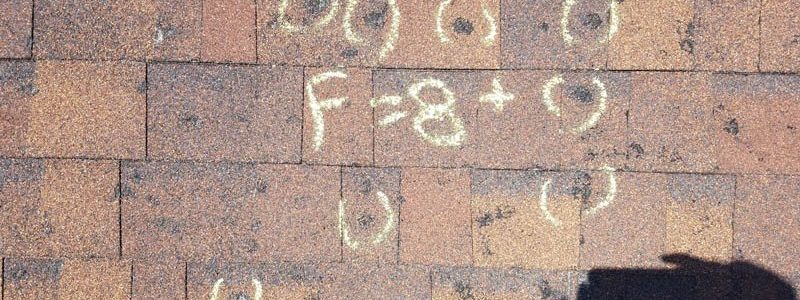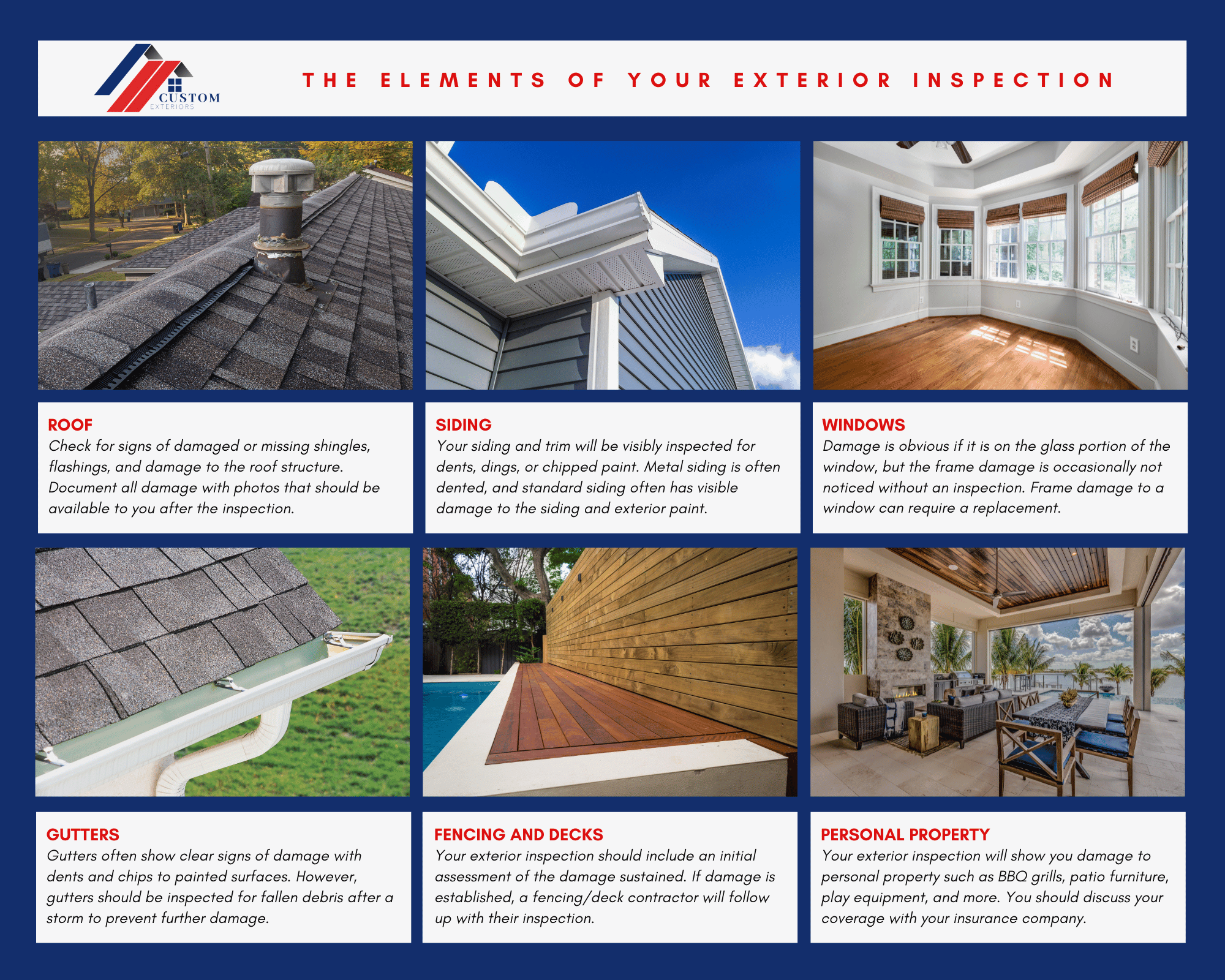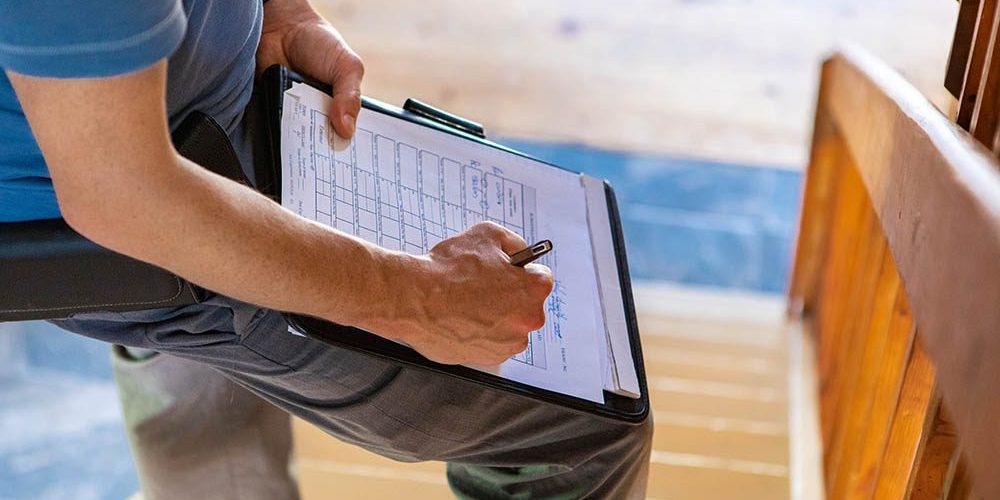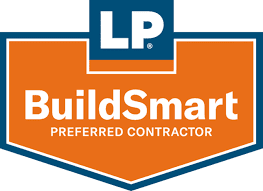
you have roof damage:
you've filed an insurance claim
what's next?
As Colorado natives and local roofing contractors, we love living in this beautiful state. However, we’re no strangers to the severe weather season that we see on an annual basis. Large hail, strong winds, and severe weather are common occurrences in the spring and summer, leaving us often facing the aftermath on our homes and businesses. This is particularly true for our roofs! If you are reading this, chances are you are dealing with a damaged roof right now and considering an insurance claim for your roof replacement. While it does seem like a daunting task, we are here to make sure your insurance inspection, estimate, and roof replacement are stress-free because you know exactly what to expect.
Because we have experienced insurance-covered roof replacements as both a homeowner and a roofing contractor, we have knowledge and experience that is important to ensure a smooth process, even if insurance talk isn’t your forte. Let’s walk through the steps together, from the initial inspection to the final inspection of your new roof!
Decoding the Complexity:
Insurance-Covered Roof Replacement
When it comes to insurance-covered roof replacement, the journey often begins with a call to your insurance company. This usually comes with the added pleasure of understanding the language of insurance policies and even coverage terms. Part of the reason this is so difficult is because homeowner’s insurance policies can vary greatly. For instance, there is a huge difference in what is covered by an ACV policy vs. an RCV policy. It is important to understand exactly what is and is not covered, as technical terms can create real issues if they aren’t properly understood.
In Colorado, the Department of Regulatory Agencies offers some insight into the insurance world behind hail damage restoration. Their number one tip for severe weather season? Become familiar with your policy. Understanding what falls under coverage and what doesn’t can be challenging, so you should contact your insurance provider about detailed policy questions. It’s important to note that even a reputable roofing company will not know the specifics of your homeowner’s insurance policy. The details of your coverage can and should be clearly explained by a representative from your insurance company.
For instance, if you have a question about an item in the estimate, your roofing contractor can help. However, when your concern revolves around insurance coverage, it’s best to direct those questions to your insurance company. They will be able to help you understand exactly what is covered by your policy. And by doing so, they provide a smooth insurance-covered roof replacement process. Because of this, most insurance agents are happy to help answer coverage questions until you have a clear understanding.

Replacement Costs Vary
Another difficult part of understanding the costs associated with an insurance-covered roof replacement is understanding how costs can vary. It’s not just a simple one-price-fits-all; a lot goes into determining the price of your roof replacement. Every roof is unique. Factors like the materials used, the size of your roof, its pitch (the slope or steepness of your roof), and the extent of damage all play a significant role in how much your replacement will cost.
For instance, consider the cost difference between two complete roof replacements—one involving a large custom home with synthetic shake shingles versus a small replacement using standard asphalt shingles. The roofing material choice plays an important role in the price. Moreover, factors unique to commercial roofing, flat roofing, and multi-family properties play a part in the final cost.
To properly address all of these factors, contractors must have extensive expertise. They should also understand roofing materials, techniques, and even the requirements or codes unique to your roof replacement. For example, a roof replacement in Niwot, Colorado, may not have the same local codes and requirements as a similarly sized and style roof replaced in Greeley, Colorado. Most jurisdictions follow the 2018 roofing codes; however, they also often have specific codes applicable to their area, such as requiring ice and water shields or drip edge.
A professional roofing contractor brings a trained eye that will catch things that may otherwise be missed. They have a deep understanding of roofing materials and installation techniques that may impact your replacement costs. They will be able to advise you on the best materials for your specific situation and help you consider factors like durability and local weather patterns. Because of this, having their expertise is invaluable. So, while it might seem like an added step, involving a professional roofing contractor can save you time, money, and a whole lot of headaches in the long run.
Complexity To Clarity
The next step includes filing an insurance claim and securing approval for the necessary repairs. This step is often time consuming and complicated as it includes a wide a range of tasks. These tasks may include documenting the extent of damage and gathering estimates for repair.
Something to keep in mind is that when replacing your roof due to hail damage, getting compensated adequately to restore your home or business to its pre-storm condition can require negotiations with your insurance company. The path to successful negotiation can be scary. Especially when addressing commercial and multi-family roof replacements and even residential roofing claims from time to time. However, you don’t have to tackle this alone. Your local roofing company should be your trusted partner. They are skilled at navigating the negotiation process with your insurance company.
With the guidance of your trusted roofing partner, you can rest assured that you will be compensated properly and be able to restore your home accordingly. Let your roofing company’s negotiation skills ensure it’s an easy journey through your insurance claim.

Anticipating Your Roof Inspection:
What To Expect
Now, let’s talk about the roof inspection, a key step to your roof replacement. Here is what you can expect during this important process.
1. Complete a thorough roof assessment
A professional roof inspection is not just a quick glance. It’s an in-depth process, and you should anticipate your roofing contractor to be on-site for some time. At Custom Exteriors, our HAAG-certified roofing inspectors examine every inch of your roof, including the shingles, flashings, vents, caulking, and each component of your roof. This thorough roof inspection ensures you are being adequately compensated for your restoration.
2. Look below the surface
It isn’t just about what’s on your roof. A qualified roofing inspector will also take a moment to check for any interior damage and assess the condition of your roof deck at this time. This may involve them needing access to your attic. While there, they can check for signs of any interior water damage or rotting roof deck. It’s also a great time to check to see if the property has spaced roof decking. Roofing codes will require the replacement of spongy or spaced decking, so this inspection is important to complete before repairs start to avoid any surprise costs during your roof replacement.
3. Document the findings
After the inspection, you should expect a detailed report of what was found. This should be a clear and concise report, complete with photos, videos, and/or verbal documentation of findings. This is your proof of the condition of your roof. This information is crucial for your insurance claim because it visually demonstrates your need for a roof replacement.

So, when your roofing inspector arrives, feel free to ask questions and get involved. Remember, this is your home, and understanding what’s happening with it is not just your right but a smart move. A good roofing inspector will be more than happy to walk you through their findings and explain things in a way that makes sense to you.
From Inspection to Solution:
Transparent Repair Estimates
After the inspection comes another critical piece to this puzzle: the estimate for your roof replacement. Here’s why a clear, detailed, and transparent estimate is so important:
- Transparency in an estimate shows that your contractor is honest and open about costs.
- A good estimate should break down all costs to help you understand exactly where your money is going.
- A detailed estimate can help avoid unexpected costs down the line.
- A detailed estimate allows your to compare costs and services between contractors.
- Knowing all of the costs ahead of time helps you plan your budget effectively.

What is included in
Your Exterior Inspection
When it comes to the elements that make up your home’s exterior, each component plays an important role in your property’s overall curb appeal and functionality. Every detail matters, from the roof that shelters you from the outdoors to the siding that adds curb appeal. Also, there are windows that connect you with the outdoors. Add to that the gutters that channel rainwater or the fencing that provides privacy and security. Or even the inviting decks where memories are made. These elements, along with the protection of personal property, create the canvas upon which you live your life. Let’s explore each component and what your contractor should be looking for.

For several reasons, understanding what to expect during an exterior home inspection after a storm is important. Firstly, it allows you to set reasonable expectations for the process. Because of this, you’re prepared for thorough home inspections. These areas will include roofing, siding, windows, gutters, fencing, decks, and personal property. This knowledge then enables you to ask informed questions. This will then allow you to gain insights into potential damage. Secondly, knowing the inspection process allows you to work well with your contractor.
Moreover, by understanding the details of post-storm inspections, you can make informed decisions about necessary repairs or replacements. Doing so prevents further deterioration and safeguards your property. Ultimately, this awareness offers you peace of mind. You can then rest assured that you’re taking steps to maintain your home’s beauty, safety, and value.
Navigating Insurance Home Inspections:
In addition to the inspection by your contractor, your insurance company will likely send out an adjuster to inspect your property. Insurance home inspections are an important step towards recouping the funds needed to return your house to pre-storm condition. While many are aware of the basics, several lesser-known aspects can impact the process and outcomes. A well-documented inspection, with contractor involvement, is the fastest way for efficient insurance approvals and timely repairs. Here are six things you might not know about getting an insurance home inspection:
Six Little Known Considerations
1. Multiple Inspections May Be Necessary: It’s not uncommon to have multiple inspections, often involving contractors and insurance inspectors. This ensures a understanding of the damages and their extent.
2. Contractor Presence Matters: Having your contractor present during the insurance inspection is important. Their expertise then helps ensure that all damages are properly documented and accounted for. By doing so, they are guaranteeing fair compensation for repairs.
3. Access to Your Entire Property is Required: The inspection process extends beyond the exterior of your home. Inspectors will require access to your entire property. This is including your house’s interior and front and back yards.
4. Exterior Repairs Can Be Noisy: Anticipate that exterior repairs can create noise and disruptions. So, depending on the damage extent, interior access may be needed. Knowing this allows you to be prepared.
5. Documentation is Key: The inspection should be documented with photos and possibly video. This is valuable evidence for your insurance claim and ensures transparency.
6. Swift Inspection Benefits: Completing the inspection promptly has its advantages. It speeds up the insurance approval process. By doing this, they are allowing you to move forward with necessary repairs swiftly. This can help you avoid the post-storm repair frenzy and potential lack of material availability.
Making Informed Choices For
Roofing Insurance Claims
It’s crucial to remember that it’s your insurance footing the repair bill, not your personal finances. A wise plan is to choose the company that aligns with your preferences over the cheapest option. However, your insurance policy will require that you pay your deductible, regardless of the overall repair cost. Be prepared for this financial commitment based on your policy terms.
Additionally, homeowners should exercise caution when roofing contractors offer to “cover their deductible.” This practice is not only against the law but also a matter taken seriously by insurance commissions. It’s a principle that reputable roofing contractors uphold with integrity.

The Value Of Choosing A
Trusted Roofing Company
Choosing a local roofing company means having a partner within reach. They are just a short drive away. Because of this, making appointments, inspections, and any follow-up work is very convenient. Being local also means they are well-versed with your area’s unique weather challenges and building codes. Because of this, a local roofing company understands your community’s specific needs and architectural trends. They are familiar with the regional roofing styles, materials, and trends. This knowledge ensures that your roofing project blends seamlessly with the surrounding homes.
Additionally, a local roofing company’s reputation is often built within the community. They have a vested interest in maintaining their standing. This also encourages them to build lasting relationships. This can often mean high-quality work, exceptional customer service, and a commitment to delivering on promises. This also applies during urgent repairs or storm damage. Because of their location, a local roofing company can respond quickly. They can assess the situation quickly, provide solutions, and initiate repairs to safeguard your property.
Choosing a local trusted roofing company isn’t just about hiring a contractor – it’s about having a partnership rooted in shared values. It’s about accountability and a commitment to your community’s well-being. At Custom Exteriors, we take pride in being an integral part of our community. Our local expertise, dedication, and personalized approach make us the preferred choice for all your roofing needs. With us, you’re not just getting a roofing solution – you’re getting a reliable partner dedicated to improving the quality and safety of your home.
Next up
the estimate process
Contact Us Today
We Service and Support the Following Brands









Contact
Custom Exteriors, LLC
2881 S. 31st Ave, Greeley, CO 80631
109 E. 17th St. Ste 5822, Cheyenne, WY 82001
102 S. Tejon St. Ste 1100, Colorado Springs, CO 80903
404 Broadway, Eagle CO 81631
Phone: 970-460-8714
Toll Free: 800-580-0131
Quick Links
© 2022 Custom Exteriors, LLC

